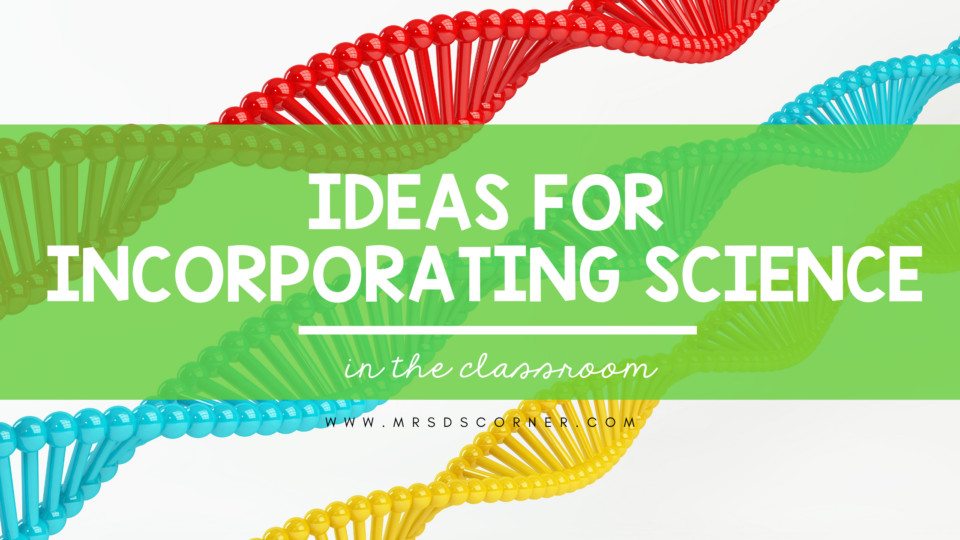Incorporating science in the classroom can be trickier than one may think! With so many other subjects to teach, it’s easy for science to take a backseat. Here are some ideas for making it come alive in your classroom this year!


As educators, we are constantly searching for ways to make our lessons more engaging and interactive, especially when it comes to teaching science. Science is a subject ripe for hands-on exploration and experimentation, so incorporating it into classroom activities is a great way to get students excited about learning. Here are some ideas for incorporating science into your classroom:
1. Science Experiments
Experiments are one of the easiest ways to incorporate science into your classroom. Plenty of easy and safe science experiments can be done using everyday materials. For example, you can have students conduct experiments with water to learn about buoyancy, density, and gravity. This is a great way to get students involved in the scientific process and to teach them some basic scientific principles.
2. Science Demonstrations
Demonstrations are another great way to incorporate science into your classroom. You can use demonstrations to illustrate complex concepts or to show the results of an experiment. For example, you can demonstrate the effects of air pressure using a balloon or show the effects of acid on different materials.
3. STEM Challenges
STEM challenges are a fun and engaging way to incorporate science, technology, engineering, and math into your classroom. These challenges can be anything from building a bridge out of toothpicks and marshmallows to creating a water filtration system using everyday materials. STEM challenges encourage students to think creatively and to work together to solve problems.
4. Field Trips
Field trips are a great way to incorporate science into your classroom. Take your students to a local museum or science center to learn about different scientific concepts. You can also take them on a nature hike to learn about different plants and animals.
5. Science Fairs
Science fairs are a great way to get students excited about science. Have your students design and conduct their own experiments and then present their findings to the class or at a science fair. This is a great way to encourage students to think critically and develop their own scientific questions.


6. Generation Genius
Another great way to incorporate science into your classroom is by utilizing a program like Generation Genius. This online resource provides teachers with interactive video lessons on a variety of science topics, including the physical, earth, and life sciences. The videos are accompanied by lesson plans, activities, and quizzes, making it easy for teachers to integrate these lessons into their existing curriculum.
7. BrainPOP
BrainPOP is the perfect solution for incorporating more science in the classroom! With BrainPOP’s comprehensive library of animated videos, teachers can easily integrate engaging and informative content into their lesson plans. The videos cover many topics, from physical sciences, such as chemistry and physics, to earth sciences, like geology and astronomy. Plus, each video includes an accompanying quiz so students can test their knowledge after watching it.
8. Magic School Bus Videos and Books
The Magic School Bus is a beloved educational series that has entertained and educated children for decades. The series follows the adventures of Ms. Frizzle and her class as they explore the world of science through their magical school bus. The multimedia series includes books and videos, making it a versatile tool for incorporating science into your classroom.
Each episode focuses on a specific topic – from the water cycle to the human body – and takes students on a thrilling adventure to explore it. The videos are informative but also fun and entertaining, which helps keep students engaged and interested.
In addition to the videos, The Magic School Bus also includes a wide range of books covering various scientific concepts. These books are written in a fun and informative style that is accessible to children, and they include detailed illustrations to help bring science to life.
9. Mystery Science
Mystery Science is an exciting and innovative way to incorporate science into your classroom. This online resource offers teachers a vast library of science lessons that are designed to be both engaging and informative for students. Mystery Science lessons are structured around captivating mysteries that spark students’ curiosity and encourage them to think critically.
10. Digital Science Activities
Digital science activities are a great way to enrich your classroom’s science curriculum with interactive and engaging experiences. There are numerous online resources that offer a wide range of digital science activities and experiments that cover a variety of topics, from physical sciences like chemistry and physics to life sciences like biology and environmental science. This bundle of digital science and social studies activities is a great example of how technology can help make science in the classroom come alive.


11. Hands-on Science Activities
Sometimes hands-on science activities don’t include science experiments – and that’s okay! Things like the Science and Social Studies Adapted Work Binder can provide all of the science activities your students need to get excited about the subject!


Incorporating science into your classroom doesn’t have to be complicated. With a bit of creativity and some simple materials, you can create engaging and interactive lessons that will get your students excited about science. So why not give some of these ideas a try and see how they can enhance your classroom experience?

